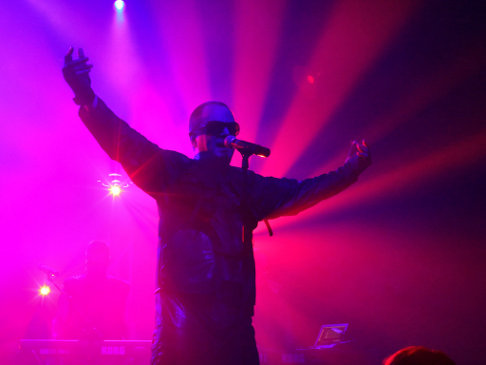
Front 242 - Music, Demoscene and Beyond
Written by Magic of Nah-kolor

Hugi got into an exclusive talk with Patrick Codensys of Front 242 about - among other things - the demoscene, their concert at the Alternative Party 2008 and their involvement with computer games.
Photos taken by DiamonDie
Front 242 Amiga screenshots supplied by Patrick Codensys
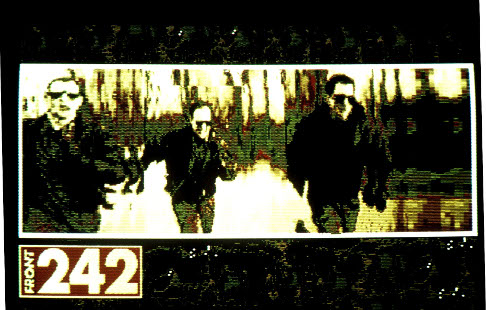
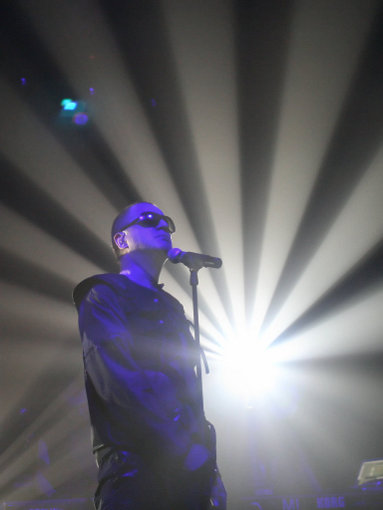
e-mail during my holiday on Tenerife , I got a reply from Patrick Codensys on the 9th of September 2009: "Sorry about the delay .... 5 months! Anyway your e-mail popped up and I checked the magazine... nice and interesting... So, if I could be of any help; feel free to ask me. Also, if you want to meet, I will be at Open Circuit in Hasselt - not exactly Demoscene but interesting also." Unfortunately we don't have any budget for visits like this so Patrick was nice enough to agree on an interview via e-mail. If you have never heard of Front 242, it's an 80's band from Belgium. Pioneers in creating electronic and industrial music. I noticed they gave a concert at the Alternative party 2008 so I wondered what other knowledge Patrick has about the demoscene. Patrick comments: "Throughout my music 'career' I always was interested in Lo-tech; mainly through music and graphics. I was aware of some underground artists, sort of circuit benders in the 80's but I don't recall meeting a 'demoscene' or a community at the time. I honestly discovered the demoscene late in 2000... my knowledge is like everyone's W.Y.S.I.W.Y G. - always different approaches and challenges of vintage lo-tech, that's the essence of it I guess." So how and why exactly did Front 242 end up doing a live performance at The Alternative Party 2008? Patrick explains: "Some of the promoters were F242 fans for a while. We never played Finland and since their 'Alternative Party' was improving on the audience level but also organization; they managed to invite a 'Live' band. It was very carefully put together, I even met an Alternative representative in Brussels to have a first contact and an interview ."
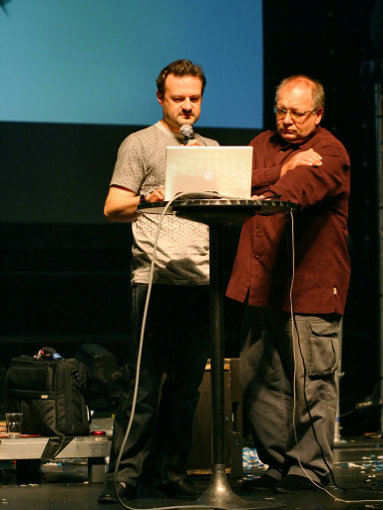
While doing some research for this article I read somewhere on the Internet that among other things, Front 242 used both the Amiga and Atari computers for their music and video work. Two brands of computers which had a great role in the past of the demoscene. What can Patrick tell us about using Amiga and Atari in the past? Patrick: "We had an Acorn BBC computer - but to tell you the truth it was more of a first start computer, we never used it for artistic purposes. At the time, music sequencers like
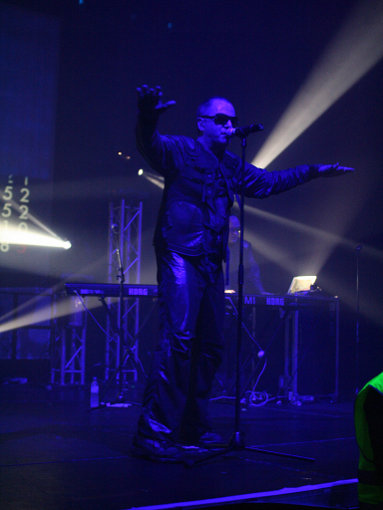
the MC-4 from Roland were a better option to manage sound sequences. The first real computer musical sequencer was the Commodore 64 (later 128). Coming from analog CV systems to MIDI systems allowed a new management of the music, not always more creative but different. Finally, in the mid 80's we used an Atari 1024, then 1040 until 1994. On the graphic level, we started with an Amiga 1000. Although Amiga could be used for sound, we separated the use of computers either specifically for music (see above) or graphics. We produced our first press pictures with that machine. I remember using a surveillance B/W camera with a plexiglas turning element with the RGB colors. Each color scanning taking 3 real minutes, the subject could not move to succeed doing a full color snapshot. Later on we used the Amiga 500 for most of the graphic works. It was important to develop a typical aesthetic linked to the use of those machines, that's why Front242 reproduce a lot of jigsaw designs, obvious pixels and TV roaster. Concerning the TV roaster, there was no choice, we needed to take a picture Ektachrome from the screen. The more modern graphic campaigns started with the Quadra MacIntosh. All those machines came with unfriendly technical manuals, formats and compatibilities very often different (different voltages, cables, etc...) and needed human bright ideas and/or several interfaces. Still as today, we keep the same old technology reflexes in our approaches regarding new equipment."
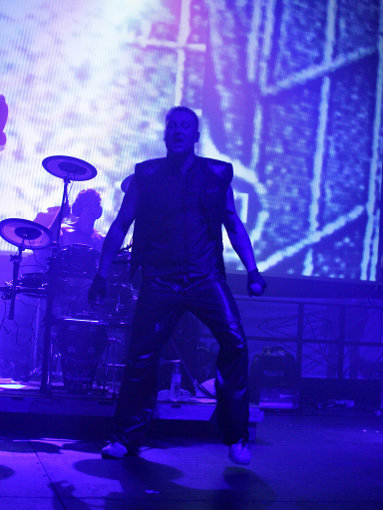
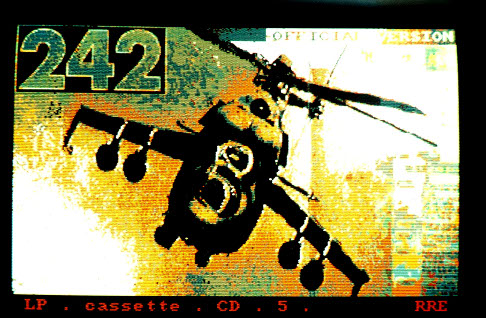
performances. Where do Front 242 get their ideas and inspiration
from for there projections, clips
and graphic elements used in live shows and videos? Patrick tells us: "Strange enough, when we
discovered synthesizers, we knew we had to give a new life to those machines. Rather than being influenced by the anglo-saxon
heritage (Rock, Blues, Jazz, etc...) we wanted to explore new directions, create a new Art. The art of Cinema was perfect to be
inspired in designing sounds (soundscapes) and the Architecture was perfect to organize the music (sequencing). So those
2 disciplines were more than influential. During the 80's, post-modern architecture matched our methods and
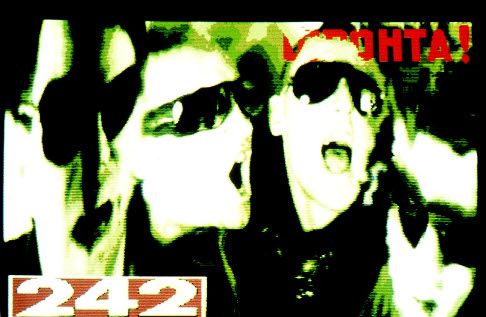
post-modern philosophy our minds."
Front 242 released 10 albums in the period from 1982 till 1993. And then after a period of silence (except for some live albums
and a remix album) a new album called 'Pulse' was released in 2003.
What software and computers did Front 242 use to make the
album 'Pulse' and what was different in making this album compared to their albums Front 242 made from 1982 to 1993? Patrick:
"Mac Apple G3 and G3 powerbook bronze + Cubase and Nuendo. Front242 did actually used the same technology; analogic and some
digital synthese. With 'Pulse', we wanted to come back to the roots of our musical influences,
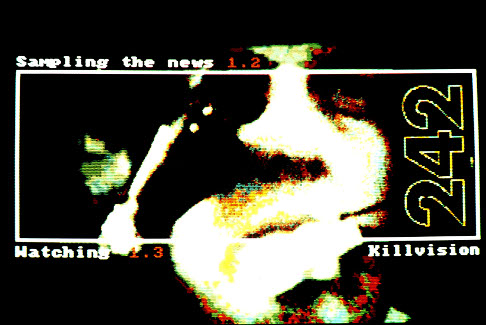
especially Krautrock. Our first album 'Geography' was created with that sort of background: German AntiRock (KrautRock), Industrial music, and electropop (Mute, etc...). We needed to connect with the first motivations we had in the early 80's to find back a healthy way to produce music. Therefore, we came back with more instrumental and 'out of song format' tracks. Compared to the other albums that followed Geography, we can say that 'Pulse' does not pretend to innovate but find back a creative spirit - so more based on the method than the form."
I also found out during my research that Front 242 wrote the music for a game. It's an action/adventure game called 'Cipher Complex'. What does Front 242 have with video games? "Game music is a big business and where there is money, you need the right inputs or you won't be part of that kind of project. In the case of Cipher and Wing Commander we were invited by people who were 242 fans and wanted us. Other occasions were never offered to us", Patrick comments and continues: "As experience, I do enjoy it although it is very formatted - like Cinema music. Everybody wants those Koto or Timpani drums (like in the Matrix), a Prodigy type of dynamic (Firestarter) with some classical arrangement (Gladiator)... Like I said Game music has its formats too. I believe it is time to propose alternative underground games with unusual electronic tracks - a domain where subculture still needs to find its way."
Magic